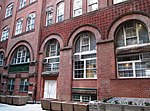116 John Street
Art Deco architecture in ManhattanFinancial District, ManhattanManhattan Registered Historic Place stubsManhattan building and structure stubsOffice buildings completed in 1931 ... and 2 more
Office buildings in ManhattanOffice buildings on the National Register of Historic Places in Manhattan

116 John Street is a historic office tower at the southwest corner of John Street and Pearl Street in the Financial District of Lower Manhattan in New York City. It was built in 1931, and is a 35-story brick and terra cotta building consisting of a three-story base, a 19-story shaft, and 12 upper stories that recede in a series of setbacks. The building features Art Deco style design elements at the recessed entrances and in the lobby. Built as a speculative office building for insurance companies, the building interior was rehabilitated in 2013 and some floors converted to apartments.: 3–4, 7 It was listed on the National Register of Historic Places in 2014.
Excerpt from the Wikipedia article 116 John Street (License: CC BY-SA 3.0, Authors, Images).116 John Street
John Street, New York Manhattan
Geographical coordinates (GPS) Address External links Nearby Places Show on map
Geographical coordinates (GPS)
| Latitude | Longitude |
|---|---|
| N 40.7075 ° | E -74.005833333333 ° |
Address
116 John Street
John Street 116
10038 New York, Manhattan
New York, United States
Open on Google Maps








